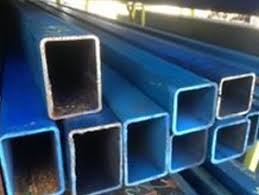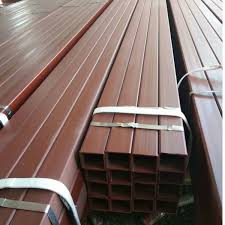Painted hollow steel features
Technical Properties:
Painted hollow steel profile has many technical features.


- Surface Treatment: Prior to painting, HSS may undergo various surface treatments, such as pickling, blasting, or phosphating, to enhance the adhesion of the coating and provide a protective layer against corrosion.
- Welding and Joining: HSS can be welded or joined using techniques like gas metal arc welding (GMAW), shielded metal arc welding (SMAW), or resistance welding. The specific method chosen depends on the HSS grade, the thickness of the sections, and the desired joint properties.
- Fireproofing: For applications where fire resistance is critical, HSS can be treated with fireproofing coatings or intumescent paints. These materials expand and char when exposed to fire, creating a protective barrier that insulates the steel and delays its failure.
- Acoustic Properties: Depending on the HSS shape, dimensions, and the type of paint coating, HSS can have varying acoustic properties. For instance, hollow sections with thicker walls and specific geometries can be used to reduce noise transmission in buildings.
- Thermal Properties: HSS can be used in building frames to provide thermal insulation, reducing the need for excessive heating or cooling. This can contribute to energy-efficient buildings and lower energy costs.
Mechanical Properties:
While the basic mechanical properties of HSS have been discussed, it’s worth noting that the paint coating itself can influence the overall performance of the material. For example:
- Corrosion Resistance: The choice of paint coating is crucial for protecting HSS from corrosion, especially in harsh environments. Coatings with high durability, such as epoxy or polyurethane, can provide excellent resistance to weathering, chemicals, and salt.
- Adhesion: The adhesion of the paint coating to the HSS surface is essential for its long-term performance. Improper adhesion can lead to delamination, blistering, or premature failure.
- Impact Resistance: While the mechanical properties of the steel itself contribute to impact resistance, the paint coating can also play a role. Coatings with good toughness can help to absorb energy and prevent damage to the underlying steel.
- Fatigue Resistance: HSS can be subjected to cyclic loading, which can lead to fatigue failure. The choice of paint coating can influence the fatigue resistance of HSS, as it can help to prevent stress concentration and reduce the risk of crack initiation.
Environmental Considerations:
In recent years, there has been increasing emphasis on sustainable construction practices. Painted HSS can contribute to environmentally friendly building projects in several ways:
- Recyclability: HSS is a recyclable material, which means it can be recovered and processed into new products, reducing the demand for virgin steel.
- Energy Efficiency: As mentioned earlier, HSS can contribute to energy-efficient buildings through its thermal properties.
- Low Maintenance: Painted HSS requires minimal maintenance, which can reduce the overall environmental impact of a building over its lifespan.
- Reduced Embodied Carbon: Compared to other materials, HSS can have a lower embodied carbon footprint, which refers to the greenhouse gas emissions associated with its production and transportation.

By carefully considering the technical, mechanical, and environmental factors, engineers and architects can select the appropriate painted HSS for a wide range of applications, ensuring both structural integrity and sustainability.
Price table
| Section Size | Type | Wall Thickness (mm) | Yield Strength (MPa) | Tensile Strength (MPa) | Elongation (%) | Price (USD/ton) |
|---|---|---|---|---|---|---|
| Small (50×50 mm) | Standard | 2.0 | 250 | 400 | 20 | 740 |
| Small (50×50 mm) | Premium | 2.5 | 275 | 450 | 22 | 770 |
| Medium (100×100 mm) | Standard | 3.0 | 250 | 400 | 18 | 760 |
| Medium (100×100 mm) | Premium | 3.5 | 300 | 460 | 20 | 790 |
| Large (150×150 mm) | Standard | 4.0 | 250 | 400 | 15 | 780 |
| Large (150×150 mm) | Premium | 4.5 | 320 | 470 | 18 | 810 |
| Extra Large (200×200 mm) | Standard | 5.0 | 250 | 400 | 12 | 800 |
| Extra Large (200×200 mm) | Premium | 6.0 | 350 | 500 | 15 | 880 |
Legend:
- Standard: Basic painted hollow sections with regular properties.
- Premium: Higher quality painted hollow sections with improved mechanical properties.
- Yield Strength (MPa): Stress at which the material begins to deform plastically.
- Tensile Strength (MPa): Maximum stress that the material can withstand.
- Elongation (%): The amount the material can stretch before breaking.